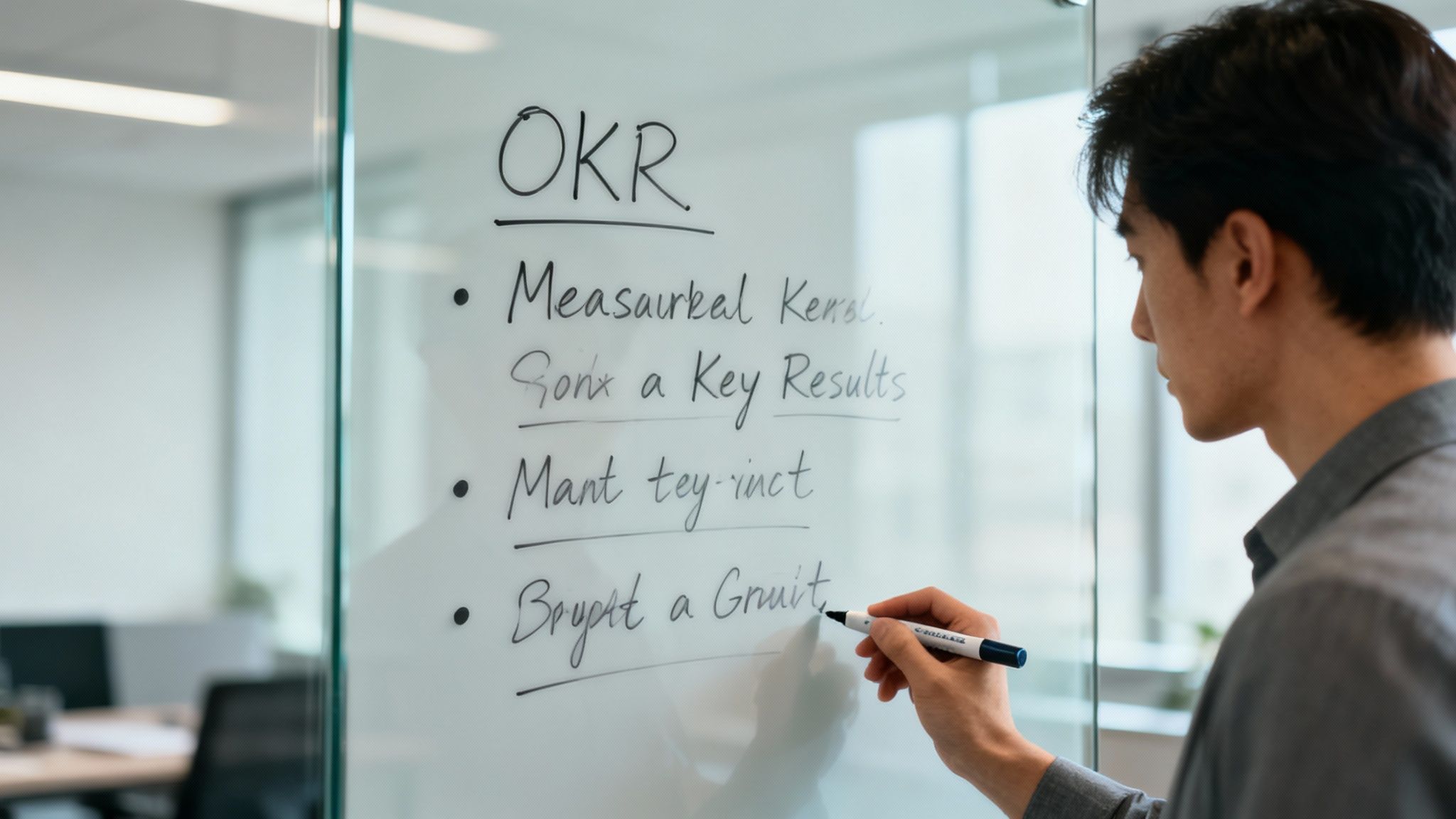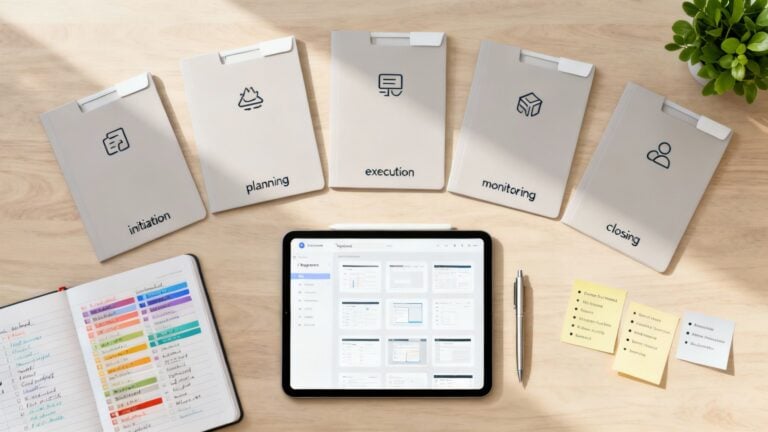In today's competitive landscape, the ability to improve employee productivity is not just an advantage; it's a critical driver of success. For mid-sized teams and agencies, finding the right balance between performance, engagement, and well-being is key to sustainable growth. However, many common strategies offer generic advice that fails to address the core challenges of modern work, such as balancing autonomy with alignment and preventing burnout. This guide moves beyond the basics, offering ten proven, actionable strategies designed for immediate implementation.
We'll explore how establishing clear goals, optimizing workloads, and fostering a supportive culture can transform your team's output. Throughout this article, we will show you not just what to do, but how to do it effectively.
Furthermore, we'll highlight how leveraging tools like TimeTackle can automate time capture and provide the data-driven insights needed to make these strategies stick. This ensures every effort is measured, meaningful, and aligned with your most important business objectives. Prepare to discover how you can create a more focused, motivated, and efficient workplace, turning productivity from a buzzword into a tangible asset.
1. Establish Radical Clarity with Goal Setting and Clear Objectives (OKRs)
To genuinely improve employee productivity, you must first define what "productive" means for your organization. The Objectives and Key Results (OKR) framework, pioneered by Intel and popularized by companies like Google, provides a transparent structure for this. It connects ambitious company goals with the specific, measurable results that individuals and teams must achieve. This isn't just a glorified to-do list; it’s a strategic alignment tool that gives every employee a clear "why" behind their work.
When team members see how their individual contributions propel the organization forward, their motivation and focus skyrocket. Disjointed efforts transform into a unified force for growth, creating the foundation for a high-performance culture.
How to Implement OKRs Effectively
Implementing OKRs requires discipline and a commitment to transparency. The goal is to create a clear line of sight from daily tasks to the company's highest aspirations.
- Set Focused Goals: Limit each team or individual to 3-5 key objectives per quarter to prevent overwhelm and maintain focus on what truly matters.
- Balance Ambition: Aim for a mix where about 70% of key results are achievable (stretch goals) and 30% are aspirational (moonshots) to encourage innovation without causing burnout.
- Ensure Transparency: Make all OKRs visible across the organization. This fosters cross-functional alignment and helps teams understand how their work interconnects.
- Regular Check-ins: Review and communicate progress on OKRs weekly or bi-weekly. This keeps goals top-of-mind and allows for agile adjustments.
Connecting daily work to these high-level objectives is critical. With TimeTackle, you can automatically align time captured from employee calendars with specific OKRs. This provides real-time visibility into how time investment translates directly into goal progression, closing the loop between effort and outcome.
2. Offer Flexible Work Arrangements
One of the most powerful ways to improve employee productivity is by moving away from the traditional 9-to-5, in-office model. Offering remote work options, flexible schedules, or hybrid arrangements acknowledges that productivity isn't tied to a specific location or time block. This approach empowers employees to work when and where they are most effective, accommodating different peak productivity hours and personal responsibilities.
When employees gain control over their schedules, they can better manage work-life integration, reduce commute-related stress, and create a focused work environment. Companies like GitLab and Shopify have demonstrated that this autonomy leads to higher engagement and a culture built on trust and results, not just hours logged at a desk.
How to Implement Flexible Work Effectively
A successful flexible work policy is built on a foundation of clear expectations and robust communication, ensuring that autonomy doesn't lead to misalignment.
- Establish Clear Communication Protocols: Define core availability hours and preferred communication channels (e.g., Slack for quick updates, email for formal documentation).
- Invest in Collaboration Tools: Equip your team with the necessary technology like Asana, Slack, and Zoom to facilitate seamless collaboration regardless of location.
- Define Expectations for Availability: Clearly outline expected response times for different communication methods to manage team and client expectations.
- Focus on Outcomes, Not Hours: Shift performance metrics to be results-oriented. Evaluate employees based on the quality and completion of their work, not the time spent in a chair.
With flexible schedules, understanding where time is actually going becomes crucial. TimeTackle helps bridge this gap by automatically capturing calendar data to provide clear insights into work patterns without manual timesheets. This allows managers to ensure productivity remains high and resources are allocated effectively, even with a distributed team.
3. Professional Development and Learning Opportunities
To improve employee productivity for the long term, you must invest in your team's growth. Providing continuous learning through training, certifications, and skill development keeps employees engaged, competent, and adaptable. When organizations prioritize employee growth, team members feel valued and are more motivated to enhance their performance, directly addressing skill gaps and preparing them for future challenges.
This investment pays dividends in retention and innovation. Companies like Amazon, which invests over a billion dollars annually in employee development, and Google, with its famous "20% time" for personal projects, understand that a skilled workforce is a productive one. This strategy builds a culture where expertise and continuous improvement are core values.
How to Implement Learning Opportunities Effectively
A successful development program goes beyond simply offering courses; it integrates learning into the career path and daily workflow, ensuring the time invested yields tangible results.
- Align Learning with Career Goals: Connect training opportunities directly to individual career development plans so employees see a clear path for advancement.
- Create a Dedicated Budget: Allocate a specific learning budget per employee or team to empower them to seek out relevant courses, workshops, or certifications.
- Encourage Peer-to-Peer Learning: Foster a collaborative environment by creating platforms for knowledge sharing, such as internal workshops or mentorship programs.
- Measure Skill Progression: Track and measure how new skills are being applied to projects and how they contribute to performance improvements and overall team capabilities.
Time is the most valuable resource for training. Using a tool like TimeTackle helps quantify the hours dedicated to professional development. By automatically capturing this time, you can analyze the ROI of your learning initiatives and ensure that this crucial investment is balanced with project deliverables.
4. Foster a Culture of Recognition and Appreciation
To consistently improve employee productivity, you must create an environment where effort and achievement are actively acknowledged. Recognition and reward programs transform acknowledgment from an occasional afterthought into a core part of your company culture. By celebrating accomplishments, you reinforce desired behaviors and show employees that their contributions are valued, which directly fuels motivation and engagement.
This goes beyond annual bonuses. A culture of appreciation, where praise is timely and specific, makes employees feel seen and connected to the company's success. Companies like Salesforce and Zappos have demonstrated that when recognition is frequent and meaningful, it creates a powerful positive feedback loop that elevates performance across the board.
How to Build an Effective Recognition Program
An effective program is built on fairness, transparency, and a genuine desire to celebrate wins, both big and small. The goal is to make recognition a daily habit, not a rare event.
- Be Timely and Specific: Acknowledge accomplishments as they happen. Instead of a generic "good job," say, "Your detailed analysis on the Q3 report saved the team hours of work and helped us pinpoint a key issue."
- Embrace Peer-to-Peer Recognition: Empower employees to celebrate each other's successes. Tools like Bonusly or Karma facilitate this, fostering teamwork and positive relationships.
- Balance Monetary and Non-Monetary Rewards: While bonuses are appreciated, non-monetary rewards like extra time off, professional development opportunities, or public praise can be equally powerful.
- Align with Company Values: Ensure your rewards system reinforces the core values of your organization, rewarding not just outcomes but also the behaviors you want to cultivate.
By understanding how employees invest their time, you can better identify high-impact contributions that deserve recognition. TimeTackle helps reveal the effort behind the results, providing data-backed insights to ensure your recognition program acknowledges the true drivers of success.
5. Effective Time Management and Workload Optimization
To improve employee productivity, you must equip your team with the skills to manage their time and workloads effectively. This goes beyond simple scheduling; it involves strategic prioritization, eliminating time-wasting activities, and ensuring workloads are balanced to prevent burnout. When employees feel in control of their day, they can dedicate focused energy to high-impact tasks, resulting in higher-quality work and greater innovation.
Empowering employees with time management principles turns reactive, overwhelmed teams into proactive, efficient units. This shift is crucial for maintaining momentum on long-term projects and fostering a sustainable, high-performance environment where everyone can thrive.
How to Implement Better Time Management
Implementing effective time management requires a systemic approach that combines individual techniques with supportive company policies. The goal is to create an environment where deep work is protected and prioritized.
- Audit and Eliminate Low-Value Meetings: Regularly review recurring meetings and cancel those that lack clear agendas or outcomes. Encourage asynchronous communication for simple status updates.
- Implement Focus Time Blocks: Introduce "no-meeting" periods, like Microsoft’s "No Meeting Wednesdays," to give employees uninterrupted time for concentrated work.
- Teach Prioritization Frameworks: Train your team on methods like the Eisenhower Matrix (urgent/important) to help them make better decisions about where to focus their energy.
- Monitor and Adjust Workloads: Regularly check in with team members to assess their workload. Use this feedback to rebalance tasks and prevent individuals from becoming overwhelmed.
With TimeTackle, you can gain visibility into how time is actually spent across the team, identifying patterns of overwork or excessive meetings. This data allows you to proactively adjust workloads and implement smarter time management strategies. To dive deeper into specific techniques, explore these 10 rock-solid time management strategies to boost your productivity.
6. Invest in Comprehensive Health and Wellness Programs
To genuinely improve employee productivity, you must support the people doing the work. Comprehensive wellness initiatives that address physical, mental, and emotional health are not just perks; they are fundamental to creating a resilient and high-performing workforce. Healthy employees are more engaged, miss fewer workdays, and maintain better focus. This demonstrates a commitment to employee wellbeing beyond their direct output, fostering loyalty and a positive culture.
When an organization actively invests in its team's health, it reduces the risk of burnout and stress, which are significant productivity drains. Employees who feel cared for are more likely to bring their best, most focused selves to work each day, directly impacting project quality and organizational success.
How to Implement Wellness Programs Effectively
A successful wellness program is inclusive, accessible, and tailored to the needs of your employees. It should be an integrated part of your company culture, not a separate, underutilized benefit.
- Survey Your Team: Start by asking employees what they value most. Options could range from fitness subsidies and nutrition coaching to mental health support and financial wellness workshops.
- Offer Diverse Options: Acknowledge that wellness is personal. Provide a mix of resources, such as subscriptions to mindfulness apps, flexible gym memberships, and confidential access to counseling services.
- Prioritize Mental Health: Actively promote mental health resources and work to destigmatize seeking help. Create quiet spaces for breaks and meditation to help employees recharge during the day.
- Encourage Work-Life Boundaries: A key part of wellness is preventing chronic stress. Promote practices that help employees disconnect after hours. Learn more about how to leave work at work for better mental and physical health.
By using automated time tracking, you can identify patterns of overwork or consistent after-hours activity that indicate a high risk of burnout. These insights allow you to proactively offer support and adjust workloads, using data to ensure your wellness initiatives are applied where they're needed most.
7. Cultivate a Positive Workplace Culture and Foster Team Building
Productivity isn't just about tools and processes; it's profoundly influenced by the work environment itself. A positive, inclusive workplace culture, where employees feel psychologically safe, valued, and connected, is a powerful engine for engagement and efficiency. Companies like Zappos and Patagonia have famously demonstrated that when you prioritize culture, building a team where people are motivated to collaborate and support one another, exceptional performance follows. This creates a foundation of trust where innovation and productivity can flourish.
When team members feel a genuine sense of belonging, they are more willing to go the extra mile, share ideas openly, and work together to solve complex problems. This supportive environment directly reduces friction and boosts collective output, making it a critical component to improve employee productivity.
How to Build a High-Performance Culture
A great culture is built intentionally through consistent actions and shared values, not by accident. It starts with leadership and permeates every aspect of the organization.
- Define and Live Your Values: Clearly articulate your core company values and ensure leadership consistently models these behaviors in their decisions and interactions.
- Hire for Cultural Contribution: Beyond skills, assess whether candidates will enhance and contribute to your desired culture.
- Encourage Informal Connections: Create regular opportunities for non-work-related gatherings. To truly build a foundation of trust and foster team building, understanding the 5 benefits of building a strong office coffee culture can provide a simple yet effective starting point.
- Prioritize Psychological Safety: Foster an environment where team members feel safe to speak up, ask questions, and admit mistakes without fear of retribution, as championed by Amy Edmondson.
By focusing on culture, you invest in the human element of your business. This is where TimeTackle can offer surprising insights, revealing how much time is spent on collaborative vs. individual work, helping you gauge if your cultural initiatives are translating into more effective teamwork.
8. Effective Feedback and Performance Management
Annual reviews are a relic of the past. To genuinely improve employee productivity, you need a dynamic, continuous feedback loop that helps team members understand expectations, correct course in real time, and recognize their achievements as they happen. Moving from a once-a-year event to an ongoing dialogue transforms performance management from a dreaded administrative task into a powerful tool for growth and alignment.
Companies like Adobe and Microsoft have famously shifted to a feedback-rich culture, replacing outdated ranking systems with continuous performance conversations. This approach ensures that employees receive clear, actionable guidance regularly, allowing them to adapt and enhance their work without waiting for a formal review. When feedback is timely and constructive, it directly fuels higher performance and engagement.
How to Implement Continuous Feedback
Building an effective feedback culture requires training managers and creating psychological safety for open dialogue. The goal is to make feedback a normal, expected part of the workweek, focused on growth rather than criticism.
- Establish a Regular Cadence: Institute a formal schedule for feedback sessions, such as monthly or bi-weekly check-ins, to ensure consistency and prevent it from falling through the cracks.
- Train for Quality: Equip managers with frameworks like Radical Candor to deliver feedback that is both direct and empathetic. Focus on specific behaviors and outcomes, not personality traits.
- Make it a Two-Way Street: Encourage employees to provide feedback to their managers and peers. This creates a culture of mutual accountability and continuous improvement for everyone.
- Connect Feedback to Goals: Tie performance conversations directly to individual and team objectives. This helps employees see how their development contributes to broader company success.
9. Optimize Your Technology and Tool Stack
Providing employees with the right technology is foundational to any strategy designed to improve employee productivity. The right tools reduce friction, automate repetitive work, and eliminate frustrating bottlenecks, allowing your team to focus on high-value, strategic activities. Conversely, an outdated, fragmented, or poorly chosen tech stack creates drag, wastes valuable time, and breeds frustration.
A well-curated set of tools, from project management platforms like Asana to communication hubs like Slack, acts as a force multiplier for your team's efforts. When systems integrate seamlessly and serve a clear purpose, you create an environment where efficiency becomes the default, not the exception. This strategic approach transforms technology from a necessary expense into a powerful driver of performance and engagement.
How to Implement Technology Optimization Effectively
A successful tech stack isn't just about having the latest software; it's about strategic selection, integration, and adoption. The goal is to build a cohesive digital ecosystem that supports your team’s workflow without adding complexity.
- Audit Your Current Stack: Regularly review your existing tools to identify redundancies, underutilized software, and critical gaps. Involve employees in this process to understand their daily pain points.
- Prioritize Integration: Select tools that connect seamlessly with one another (e.g., your CRM with your project management tool). This prevents data silos and minimizes manual data entry.
- Provide Comprehensive Training: Never assume intuitive use. Offer thorough training and ongoing support to ensure your team can leverage the full potential of each tool you invest in.
- Develop an Adoption Strategy: Introduce new tools with a clear change management plan. Communicate the "why" behind the change, highlight the benefits for employees, and gather feedback throughout the rollout.
Understanding how your team interacts with these tools is key. With TimeTackle, you can see exactly how much time is spent in meetings and on specific projects powered by your tech stack. This data helps you measure the ROI of your software investments and identify opportunities for further optimization. For a deeper dive, explore these 6 ways technology can boost productivity.
10. Foster Autonomy and Empowerment
To truly improve employee productivity, you must shift from a culture of control to one of trust and empowerment. Granting employees autonomy over their work, from decision-making to problem-solving, is not about relinquishing control; it's about fostering ownership. When people feel trusted to manage their tasks and projects, their engagement, creativity, and sense of responsibility increase dramatically. This approach transforms employees from passive executors into proactive owners of their outcomes.
Empowered teams are more resilient, innovative, and motivated. This is the difference between an employee who simply completes a task and one who actively seeks the best way to achieve the underlying goal. By moving away from micromanagement, you create space for excellence and a more productive work environment.
How to Implement Autonomy Effectively
Empowerment doesn't mean a lack of structure. It requires clear boundaries and strategic direction to guide independent action toward collective goals.
- Establish Clear Guardrails: Define the scope of autonomy clearly. Communicate which decisions employees can make independently and which require collaboration or approval.
- Provide Strategic Context: Ensure everyone understands the company's goals and priorities. This context allows team members to make autonomous decisions that are aligned with the bigger picture.
- Trust by Default: Operate from a position of trust. Give employees the benefit of the doubt and the space to prove themselves, only intervening when necessary.
- Celebrate Learning: Encourage experimentation by treating both successes and failures as valuable learning opportunities. This creates psychological safety, which is essential for innovation.
Autonomy thrives on accountability. With TimeTackle, you can connect empowered actions to results without micromanaging. By automatically capturing how time is spent on key initiatives, you give teams the data to self-manage and prove the impact of their autonomous work, reinforcing a culture of trust and high performance.
10 Productivity Improvement Strategies Compared
| Item | 🔄 Implementation Complexity | 💡 Resource Requirements | 📊 Expected Outcomes / ⚡ Efficiency | Ideal Use Cases | ⭐ Key Advantages |
|---|---|---|---|---|---|
| Goal Setting and Clear Objectives (OKRs) | 🔄 Medium–High: structured setup, alignment cycles, regular reviews | 💡 Medium: leadership time, OKR tools, training | 📊 Clear, measurable progress and alignment; ⚡ speeds prioritization and focus | Strategic alignment, fast-growing orgs, cross-functional projects | ⭐ Aligns work to strategy; measurable outcomes; increases focus |
| Flexible Work Arrangements | 🔄 Medium: policy design, remote management changes | 💡 Medium: collaboration tools, manager training, remote infrastructure | 📊 Improved retention and work‑life balance; ⚡ can increase deep-work time | Distributed teams, talent attraction, roles suited to remote/hybrid | ⭐ Boosts satisfaction and retention; reduces overhead |
| Professional Development and Learning Opportunities | 🔄 Medium: program design, curricula and mentorship setup | 💡 High: training budgets, time allocation, vendor partnerships | 📊 Increased skills and internal mobility; ⚡ long‑term capability gains | Skill-heavy industries, succession planning, high-potential talent | ⭐ Builds capabilities and retention; fosters continuous improvement |
| Recognition and Reward Programs | 🔄 Low–Medium: define criteria, channels, and governance | 💡 Low–Medium: reward budget, platform or admin time | 📊 Immediate morale and motivation uplift; ⚡ quick engagement gains | Sales teams, performance spikes, culture reinforcement moments | ⭐ Rapid morale boost; reinforces desired behaviors |
| Effective Time Management and Workload Optimization | 🔄 Medium: cultural shift, meeting policy changes, scheduling | 💡 Low–Medium: training, scheduling tools, manager buy‑in | 📊 Reduced burnout and errors; ⚡ improves focus and throughput | Meeting-heavy orgs, knowledge workers, teams facing overload | ⭐ Improves focus, quality, and work–life balance |
| Health and Wellness Programs | 🔄 Medium–High: program design, privacy, ongoing management | 💡 High: benefits, facilities, external providers, admin | 📊 Better wellbeing, lower absenteeism; ⚡ gradual productivity improvements | Large orgs, high-stress roles, retention-focused employers | ⭐ Improves health, morale and long‑term retention; lowers costs |
| Workplace Culture and Team Building | 🔄 High: long-term change requiring leadership modeling | 💡 Medium: events, training, leadership time, ongoing attention | 📊 Stronger engagement and collaboration; ⚡ benefits are durable but slow to appear | Organizations needing cohesion, innovation, and retention | ⭐ Drives engagement, innovation and employer brand |
| Effective Feedback and Performance Management | 🔄 Medium–High: process redesign, manager training | 💡 Medium: manager time, tools, training programs | 📊 Continuous improvement and early interventions; ⚡ steady performance gains | Development-focused orgs, performance-critical roles | ⭐ Clarifies expectations, accelerates growth and development |
| Technology and Tool Optimization | 🔄 High: integration complexity, vendor selection, rollout | 💡 High: implementation costs, training, maintenance | 📊 Automation and accuracy gains; ⚡ can dramatically speed workflows | Scale-ups, remote collaboration, repetitive process automation | ⭐ Eliminates manual work, improves collaboration and data insights |
| Autonomy and Empowerment | 🔄 Medium: requires guardrails, communication and trust building | 💡 Low–Medium: training, decision frameworks, leadership alignment | 📊 Higher ownership and faster decisions; ⚡ speeds innovation and responsiveness | Creative teams, experienced professionals, flat organizations | ⭐ Boosts ownership, creativity, decision speed and engagement |
From Strategy to Action: Building a Productive Future
The journey to improve employee productivity is not a sprint with a defined finish line; it is a continuous marathon of refinement, support, and strategic adjustment. Throughout this guide, we've explored ten powerful levers you can pull, from establishing crystal-clear OKRs to fostering a culture of autonomy and empowerment. The true power, however, doesn't lie in adopting a single strategy in isolation. It emerges from creating a connected, supportive ecosystem where each element reinforces the others.
An effective feedback system, for instance, becomes exponentially more valuable when anchored to the specific goals and key results you've set. Similarly, offering flexible work arrangements yields the best results when your team is equipped with optimized technology that supports seamless collaboration, regardless of location. The common thread weaving these strategies together is a deep, data-backed understanding of how your team operates. Without it, you are merely guessing at what needs improvement.
Key Takeaways for Lasting Impact
Moving forward, concentrate on these core principles as you begin to implement change:
- Productivity is an Outcome, Not the Goal: The ultimate objective is not just to get more done, but to foster an environment where employees are engaged, motivated, and aligned with company objectives. High productivity is the natural byproduct of a healthy, supportive, and well-managed workplace.
- Integration is Key: Don't treat these ten strategies as a checklist to be completed. Instead, view them as interconnected components of a larger machine. A new wellness program will have a greater impact if workloads are managed effectively, and a recognition program feels more meaningful when tied to clear performance metrics.
- Data Overcomes Assumption: The most significant barrier to boosting productivity is often a lack of visibility into where time and effort are actually spent. Assumptions about workflow, client demands, and internal processes can lead to misguided initiatives. True progress begins with objective, accurate data.
Ultimately, the commitment to improve employee productivity is an investment in your people and your organization's future. It requires a shift from simply managing tasks to actively cultivating an environment where every individual can thrive. Start by selecting two or three strategies that resonate most with your team's current challenges. Commit to implementing them thoughtfully, measuring their impact, and iterating based on what you learn. This deliberate, focused approach will build the momentum needed for profound and sustainable organizational change, transforming your team into a more efficient, resilient, and high-performing unit.
Ready to replace guesswork with clarity and transform how your team works? TimeTackle provides the foundational data you need by automatically capturing time analytics from your team's calendar, giving you unparalleled insight into utilization, project allocation, and operational efficiency. Stop chasing timesheets and start making data-driven decisions by exploring TimeTackle today.







